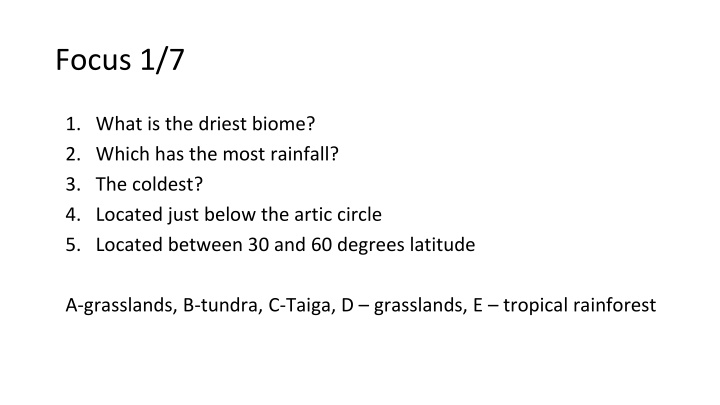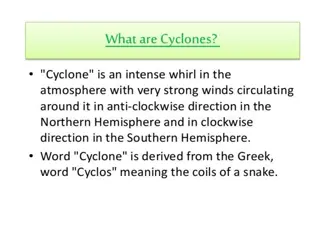Exploring Tropical Rainforests: A Diverse and Vital Ecosystem
Tropical rainforests, found near the equator, boast immense biodiversity and play crucial roles in regulating global climate and nutrient cycles. These forests thrive in humid, warm conditions with ample sunlight. Nutrients are primarily found in plants rather than the soil, and their efficient nutrient cycling results in exceptionally pure runoff water. The intricate layers of the rainforest support various plant species, creating a complex ecosystem.
Download Presentation

Please find below an Image/Link to download the presentation.
The content on the website is provided AS IS for your information and personal use only. It may not be sold, licensed, or shared on other websites without obtaining consent from the author.If you encounter any issues during the download, it is possible that the publisher has removed the file from their server.
You are allowed to download the files provided on this website for personal or commercial use, subject to the condition that they are used lawfully. All files are the property of their respective owners.
The content on the website is provided AS IS for your information and personal use only. It may not be sold, licensed, or shared on other websites without obtaining consent from the author.
E N D
Presentation Transcript
Focus 1/7 1. What is the driest biome? 2. Which has the most rainfall? 3. The coldest? 4. Located just below the artic circle 5. Located between 30 and 60 degrees latitude A-grasslands, B-tundra, C-Taiga, D grasslands, E tropical rainforest
Chapter 6: Biomes Section 2: Forest Biomes
Forest Biomes Of all the biomes in the world, forest biomes are the most widespread and the most diverse. The large trees of forests need a lot of water, so forests can be found where temperatures are mild to hot and where rainfall is plenty. There are three main forest biomes of the world: tropical, temperate, and coniferous.
Tropical Rainforests Tropical rain forests are forests or jungles near the equator. They are characterized by large amounts of rain and little variation in temperature and contain the greatest known diversity of organisms on Earth. They help regulate world climate an play vital roles in the nitrogen, oxygen, and carbon cycles. They are humid, warm, and get strong sunlight which allows them to maintain a fairly constant temperature that is ideal for a wide variety of plants and animals.
Nutrients in Tropical Rainforests Most nutrients are within the plants, not the soil. Decomposers on the rainforest floor break down dead organisms and return the nutrients to the soil, but plants quickly absorb the nutrients. Some trees in the tropical rain forest support fungi that feed on dead organic matter on the rainforest floor. In this relationship, the fungi transfer the nutrients from the dead matter directly to the tree.
Nutrients in Tropical Rainforests Nutrients from dead organic matter are removed so efficiently that runoff from rain forests is often as pure as distilled water. Most tropical soils that are cleared of plants for agriculture lack nutrients and cannot support crops for more than a few years. Many of the trees form above ground roots called buttresses or braces that grow sideways from the tree to provide it with extra support in the thin soil.
Layers of the Rainforest In tropical rain forests, different types of plants grow in different layers. There are four main layers of the rain forest: Emergent Layer Upper Canopy Lower Layer Understory
Layers of the Rainforest The emergent layer is the top foliage layer in a forest where the trees extend above surrounding trees. Trees in this layer grow and emerge into direct sunlight reaching heights of 60 to 70 m and can measure up to 5 m around. Animals such as eagles, bats, monkeys, and snakes live in the emergent layer.
Layers of the Rainforest The canopy is the layers of treetops that shade the forest floor, and is considered to be the primary layer of the rain forest. The tall trees, more than 30 m tall, form a dense layer that absorbs up to 95 percent of the sunlight. The canopy can be split into and upper and lower canopy with the lower canopy receiving less of the sunlight.
Layers of the Rainforest Epiphytes are plants that use another plant for support but not for nourishment, and are located on high trees in the canopy. Growing on tall trees allows them to reach the sunlight needed for photosynthesis, and to absorb the water and nutrients that run down the tree after it rains. Most animals that live in the rain forest live in the canopy because they depend on the abundant flowers and fruits that grow there.
Layers of the Rainforest The understory is the foliage layer that is beneath and shaded by the main canopy of a forest. Little light reaches this layer allowing only trees and shrubs adapted to shade to grow there. Most plants in the understory do not grow more that 3.5 m tall. Herbs with large flat leaves that grow on the forest floor capture the small amount of light that penetrates the understory.
Species Diversity The diversity of rainforest vegetation has led to the evolution of a diverse community of animals. Most rainforest animals are specialists that use specific resources in particular ways to avoid competition and have adapted amazing ways to capture prey and avoid predators. Insects use camouflage to avoid predators and may be shaped like leaves or twigs.
Threats to Rainforests Every minute of every day, 100 acres of tropical rainforest are cleared for logging operations, agriculture, and oil exploration. Exotic pet trading robs the rain forests of rare and valuable plant and animal species only found there. Habitat destruction occurs when land inhabited by an organism is destroyed or altered. If the habitat that an organism depends on is destroyed, the organism is at risk of disappearing.
Threats to Rainforests An estimated 50 million native peoples live in tropical rain forests and are also threatened by habitat destruction. Because they obtain nearly everything they need form the forest, the loss of their habitat could force them to leave their homes and move into cities. This drastic change of lifestyle may then cause the native peoples too lose their culture and traditions.
Temperate Forests Temperate rain forests are forests communities that are characterized by cool, humid weather and abundant rainfall where tree branches are draped with mosses tree trunks are covered with lichens the forest floor is covered with ferns They occur in North America, Australia, and New Zealand, and are dominated by evergreen trees such as the Douglas fir and Sitka spruce.
Temperate Deciduous Forests Temperate deciduous forests are forests characterized by trees that shed their leaves in the fall, and located between 30 and 50 north latitude. The range of temperatures can be extreme, with summer temperatures soaring to 35 C and winter temperatures often falling below freezing. They receive 75 to 125 cm of precipitation annually which helps to decompose dead organic matter contributing to the rich soils of the forest.
Plants of Deciduous Forests Plants in the deciduous forests grow in layers with tall trees, such as birch, dominating the canopy while shrubs cover the understory. Also, more light reaches deciduous forest floors than rain forests floors allowing more plants to grow. Temperate forest plants are adapted to survive seasonal changes. In the fall and winter, trees shed their leaves and seeds go dormant under the insulation of the soil. With the returning warmth in the spring, the trees grow new leaves and seeds germinate.
Animals of Deciduous Forests The animals of temperate deciduous forests are adapted to use the forest plants for both food and shelter. Birds cannot survive the harsh winter of the deciduous forests so each fall they fly south for warmer weather and better availability of food. Other animals, such as mammals and insects, reduce their activity so that they do not need as much food for energy, enabling them to survive the winter.
Taiga The taiga is the region of evergreen, coniferous forest below the arctic and subarctic tundra regions. The taiga has long winters and little vegetation. The growing season can be as short as 50 days with most plant growth occurring during the summer months because of nearly constant daylight and larger amounts of precipitation.
Plants of the Taiga A conifer is a tree that has seeds that develop in cones. Their leaves arrow shape and waxy coating helps them to retain water in the winter. The conifer s shape also helps the tree shed snow to the ground and not get weighed down. Conifer needles contains substances that make the soil acidic when they fall to the ground preventing plants from growing on the floor. Also, soil forms slowly in the taiga because the climate and acidity slow decomposition.
Animals of the Taiga The taiga has many lakes and swamps that in the summer attract birds that feed on insects. To avoid the harsh winters, birds migrate, while some year round residents, such as shrews, burrow underground for better insulation. Other animals, such as snowshoe hares, have adapted to avoid predation by shedding their brown summer fur and growing white fur that camouflages them in the winter snow.
Focus 1/7 What factors influence a biome? What are three characteristics of tropical rain forests? What are the three main layers of the tropical rainforest? Name and describe What is one plant in a temperate deciduous forest? What is an adaptation that the helps the plant survive? Describe one adaptation that may help an animal survive in the taiga. Name two threats to the worlds forest biomes.























